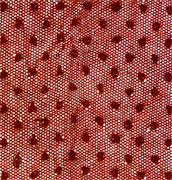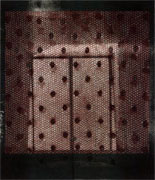click to enlarge
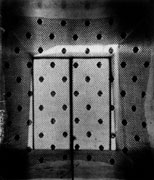
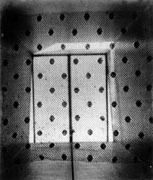
Illustration 1
Marcel Duchamp,
signed version of
Draft Pistons, 1914
© 2000 Succession Marcel
Duchamp ARS, N.Y./ADAGP, Paris.
Illustration 2
Marcel Duchamp,
unsigned version of
Draft Pistons, 1914
© 2000 Succession Marcel
Duchamp ARS, N.Y./ADAGP, Paris.
Rhonda Roland Shearer responds:
Your interesting and correct observation of the difference between the Draft Pistons in the Large Glass and his two photographs leads to other evidence of Marcel’s mischievous methods! Duchamp claims to have taken three photographs of fabric blown by air currents through a window (of the three photographs only two remain, as Duchamp claims to have lost the third).(See Illustration #1 and #2.) Richard Hamilton writes that the size of the actual cloth that Duchamp used was 1 meter square. (1)By opaque projector,
click to enlarge

Illustration 3
Enlarged drawing of
the Draft Piston
I enlarged the Draft Piston photographs to 1 meter square. The impossibility of this large 1 meter square size quickly became apparent, as the dots on the lace would then be more than 1 inch in diameter. (See Illustration #3.)Sewn dots depicted in Illustration #4occurring in antique lace are only, approximately, the size of a pencil eraser. Moreover, antique lace of similar type, when scaled to match the lace depicted in Duchamp’s photos, would measure approximately 3¾ x 4¾ inches. Therefore, the lace was not 1 meter square and could not have been in a window curtain (as scholars have assumed). Illustrations #5A, B and Ccompare old lace to one Draft Piston photo scaled to match the size and ratio of actual antique lace. #4C shows an approximation to the actual size of lace that Duchamp used for creating his Draft Piston photography. By further logic, one must also challenge whether the open “window” in the Draft Piston photograph is an actual window or the opening of a miniature box with the 3¾ x 4¾ inch lace hanging in front.
click to enlarge
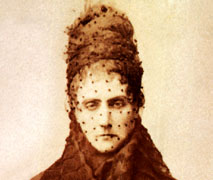
Illustration 4
Phototgraph showing a
woman veiled in antique lace
As an additional point of interest, I discovered that if one puts the two Draft Piston images side by side into a stereoviewer, an impressive 3-D stereo effect is generated. In light of Duchamp’s interest and his history in creating many original stereoworks, (including stereo-pair images to be seen in stereoviewers included is his 1941 Boîte en Valise miniature museum of his life’s work), the two Draft Pistons photos, working as a stereo pair, is not likely to be accidental. Perhaps the resulting stereo image that one sees from the fusion of the two Draft Piston photos in a stereoviewer is the third Draft Piston image that Duchamp said he “lost” and has now been refound!
- Illustration 5A
- Illustration 5B
- Illustration 5C
- Marcel Duchamp, unsigned
version of Draft Piston
s, 1914 © 2000 Succession
Marcel Duchamp ARS, N.Y./ADAGP, Paris. - An old lace, shown
here in red (originally in black)
to better illustrate the contrast - Comparison by overlaying
the old lace with the
lace in the Draft Pistons
Notes
 1. In a telephone conversation of March 10, 1999 between Thomas Girst / Art Science Research Laboratory, Inc. and Richard Hamilton, Mr. Hamilton stated that he only “made the assumption” that the “Draft Pistons” were fabricated by hanging a one-meter-square Net (net curtain or veiling) above a radiator (text in italics quoted from: Richard Hamilton. Collected Words. London: Thames & Hudson, 1982. p. 229). In addition, he mentioned that he “definitely did not get this information from Duchamp” and that he derived his guess regarding the size from the length of the “Standard Stoppages” and by looking at the 1914 photograph.
1. In a telephone conversation of March 10, 1999 between Thomas Girst / Art Science Research Laboratory, Inc. and Richard Hamilton, Mr. Hamilton stated that he only “made the assumption” that the “Draft Pistons” were fabricated by hanging a one-meter-square Net (net curtain or veiling) above a radiator (text in italics quoted from: Richard Hamilton. Collected Words. London: Thames & Hudson, 1982. p. 229). In addition, he mentioned that he “definitely did not get this information from Duchamp” and that he derived his guess regarding the size from the length of the “Standard Stoppages” and by looking at the 1914 photograph.



